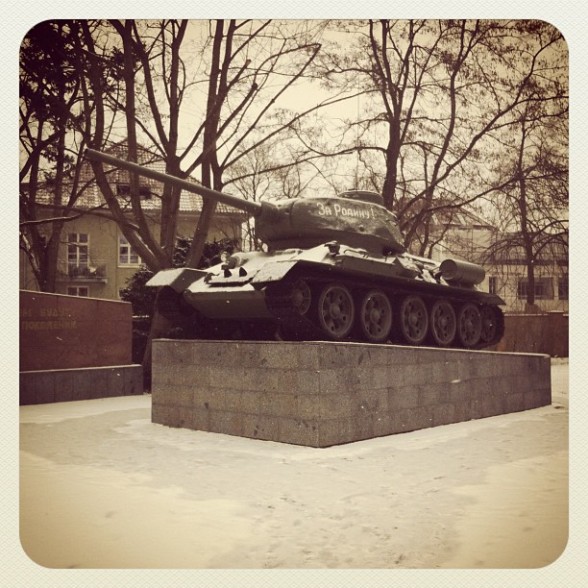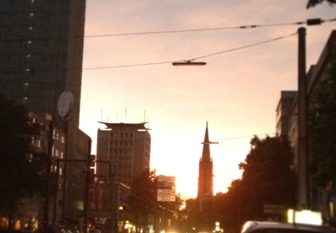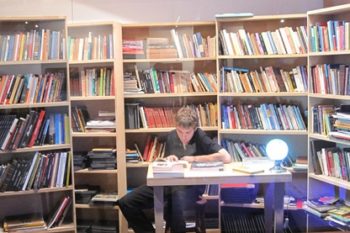I never was a soldier. Thankfully, I was in a position to forego my military service and opt for civilian service when it was my time to get conscripted with twenty. And with the paunch I developed these days any sergeant would happily refuse me for re-enlisting for even the reserve.
Not that I ever wanted to be a soldier. But coming from a family with military history, I always wonder what if must feel if your state sends you to fight against other humans in a strange country without giving you a choice, just because you are male and in a certain age group. Which is what happened to my grandfather, who served as a pioneer in the German army during the cold winters and intense summers of the Eastern front in World War II from 1941 on.
So, out of a strange coincidence, one freezing Berlin winter’s day with minus 21 degrees Celsius and the snow falling like a blanket, I trudged to the German-Russian Museum in Berlin-Karlshorst. The museum is located at the historic site of the surrender of the German Armed Forces on 8 May 1945 in Berlin, in a former officers’ mess of a pioneer school of the Wehrmacht that served as the seat of the Soviet military administration in Germany from 1945 to 1949.
After being used for various purposes by the Soviet military, a Soviet surrender museum opened in 1967 and existed until 1994, and the whole place is now run by German and Russian authorities as a bilateral institution. It’s the only museum in Germany with a permanent exhibition recalling the war of annihilation against the Soviet Union. And it’s fairly off the beaten track: the location in the Karlshorst suburb is a 45 minute train ride from the tourist sights of Berlin Mitte and only served by bus.
The building itself is not very impressive, the assortment of heavy Soviet ordinance in the park very much so. As I had expected from a former Soviet-army-run establishment, it had an air of pompousness with a T 34 tank on a pedestal, some war-graffiti of the former crew forever etched into its flank; and an array of artillery and bigger tanks lined up behind the building. I only spent a few minutes among the artillery – the Berlin frost drove me inside quite quickly.
The interior of the museum is a strange mixture of even more pompous Soviet murals depicting Stalin, a diorama of the storming of the Reichstag in 1945 and the main negotiation hall filled with commemorative plaques and red flags, and a sober main exhibition covering German-Soviet relations from 1917 on and the (ideological) origins of the conflict.
The part that concerns the war 1941 – 1945 mostly covers the war of the little man using the examples of single soldiers, displaying their war diaries or following their way through the fighting with photos and maps. Exhibits include many personal objects, such as a little sleigh that the inhabitants of besieged Leningrad used to transport food and fire wood. And their dead.
The exhibition also continues to the Soviet occupation of Eastern Germany and Soviet-German relations after 1945, both with the GDR (German Democratic Republic) and West Germany, displaying propaganda posters that look almost ironic sixty years later:

The Red Army comes to help, our gratitude is work and build-up.
When I trotted back from the museum to the bus that would take me to my apartment with Wi-Fi and a dishwasher I (still) wondered if somebody in 2012 could ever truly emulate the experiences of a World War 2 serviceman, but I saluted my grandfather for making it through that war alive so I can only learn about it in a museum and not first hand.
Read more






I’m glad to hear that your grandfather survived what must’ve been a horrible experience.
This museum sounds extremely interesting to visit and you are absolutely right: so good to be able to learn about these two eras there, at the museum and not first-hand like you grandfather did.
Marcel, I loved this post. I’ve always wondered what the German soldiers thought and felt about that war. Even though my country -Argentina- was supposedly neutral (however, some say the then president sympathized with the Nazi), we always hear accounts from the Allied point of view.
I wonder if your grandfather told you stories from the Eastern Front. I know from experience -my grandfather fought in the Spanish Civil War- that veterans don’t always like to revisit such traumatic moments.